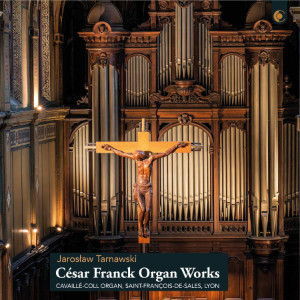
César Franck (1822-1890)
Trois pièces pour grand orgue, FWV 35-37 (1878)
Fantaisie; Cantabile; Piéce héroïque
Trois chorals pour grand orgue, FWV 38-40 (1890)
Choral No. 1 in E major
Choral No. 2 in B minor
Choral No. 3 in A minor
Jarosław Tarnawski (organ)
rec. 2021, Église Saint-François-de-Sales de Lyon, Lyon, France
RecArt 0051 [76]
The blurb says: “a key assumption of the project to release this album was to find a sound as close as possible to the composer’s intentions”. One is reminded that much of César Franck’s organ music was tailored to a particular instrument: the Cavaillé-Coll organ in Sainte-Clotilde Basilica in Paris. For better or worse, that instrument has been rebuilt or revoiced over the past century and a half, and is “only a shadow of its former glory”. Fortunately, the organ in Saint-François-de-Sales church in Lyon, installed in 1880, remains largely in the original condition. The booklet includes its specification. It is not a large instrument, but Aristide Cavaillé-Coll regarded it as one of his best. It may be of interest to note that Charles-Marie Widor’s inaugural recital on 16 December 1880 included the premiere performance of his magnificent Symphony No. 5 in F minor.
Jarosław Tarnawski first plays the Trois pièces pour grand orgue, written for the opening recital at the Palais du Trocadero, during the 1878 World Exhibition in Paris. For the occasion, Aristide Cavaillé-Coll had installed a massive four-manual instrument.
First up is the Fantasie, with a distinct improvisatory feel to it. The form is unusual: the work begins in the major key and ends in the minor. Much of its progress can be seen in terms of a dialogue between three themes, rather than standard exposition and development. The Cantabile is lyrical and contemplative in its progress. Franck takes just one idea and develops it with care. Despite a considerable climax, the piece ends quietly. The organist and composer Charles Tournemire once called it “the most perfect expression of suavity”. I understand that it was played at César Franck’s funeral. The Piéce héroïque, one of Franck’s most popular organ pieces, is in three sections. A serene “chorale” middle segment is bookended by an almost sinister main theme, supported by pulsating chords. There follows a bustling passage of arpeggios and a powerful reprise of the opening, which leads to a peroration for full organ of the “chorale”.
It is important to note that Trois chorals pour grand orgue are not based on any earlier liturgical melody. Franck puts hymn-like textures in the “tunes” he has devised himself. If anything, his melodies owe more to plainsong than to a Lutheran chorale. They sometimes are not established until after some considerable introduction. Much use is made of short motifs developed in a manner reminiscent of Franz Liszt. There is much chromaticism which adds colour and intensity. The formal constructs are significant. Each choral lasts more than 15 minutes, and requires abundant keyboard technique.
The first choral has been described as a theme from variations; the tune emerges towards the end of the exposition. Although much of the work is soft, there is an explosion of sound about midway. The music then builds up to a triumphant conclusion. The second choral is gloomy and contemplative. The melody seems to rise from the deep pedal notes. There is a hint of light created by a new theme. A dramatic interlude brings a more positive mood. This Choral builds up to a climax before shutting down to a serene conclusion. A plethora of emotions have been conjured. The third choral is like an inverted arch. It opens with bustling arpeggio figurations and loud, aggressive chords. The progress calms down a bit, and the “choral” is heard before the arpeggios return. Much of the middle section is heartbreakingly beautiful, Franck’s last thoughts, perhaps. But once again the toccata-like music re-emerges and slowly builds up to the final peroration, with a positive, but also disturbing, restatement of the theme.
The chorals were written in Nemours, Île-de-France, when Franck was convalescing. They were to be his final compositions. Sadly, he died before he could hear the works performed, although he dragged himself from his sickbed to Sainte-Clotilde to check the registrations. The work was edited by Eugène Gigout and published in 1892.
The well-produced booklet in Polish and English contains Jarosław Tarnawski’s detailed notes about the music, and an introduction to the philosophy of this recording. There is the all-important organ specification and a good historical background of the instrument. The booklet is illustrated with a well-known image of Franck “seated at the organ” in Sainte-Clotilde Basilica, and photographs of the console and the casing of the Saint-François-de-Saless instrument. Finally, we have a page of the opening bars of the Choral No. 1 in the original holograph. There is a brief bio of the performer.
I have never been a great fan of César Franck’s organ works until hearing this recording. Somehow, Jarosław Tarnawski’s stunning performance on a superb instrument made the penny drop for me. I was amazed by the power, the excitement, the drama, and the introspection of this glorious music.
John France
Help us financially by purchasing from





















